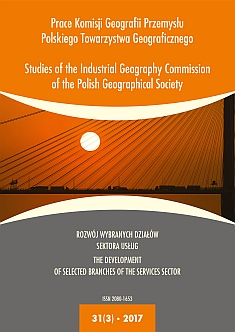Models of Operation and Development of Intermodal Terminals Based on the Example of the Greater Poland Voivodeship
DOI:
https://doi.org/10.24917/20801653.313.7Keywords:
development, intermodal terminals, intermodal transport, rail, WielkopolskaAbstract
The article presents the results of research conducted between 2013 and 2016 on intermodal transport in the Greater Poland Voivodeship, with particular emphasis on intermodal terminals operational models. In addition, the authors highlighted the barriers to the development of terminals encountered by terminal operators or potential investors. One can observe the coexistence of four models the functioning of intermodal transport in Wielkopolska. In the first one, intermodal terminal is a kind of a gate of the maritime ports. The role of the terminal is the extension of the port logistics chain in the inland regions. In the second model, intermodal transport offers additional services offered by logistics firms. In the third model, terminals offer additional services to the industrial parks or special economic zones. In the last model the terminals are located near the industrial plants with high requirements for transport services. Our study indicated that all four models are operational on the regional market. It also indicated the need for model financial support for terminals from the UE funds, which indicate whether to invest in one or two big terminals in the region or a net of several smaller ones. In addition to the necessity of investment it is to increase of awareness among entrepreneurs and public administration.
Downloads
Metrics
References
Banister, D. (2005). Unsustainable transport: city transport in the new century. Abingdon: Routledge – Taylor & Francis.
Beim, M., Mazur, B., Soczówka, A., Zajdler, R. (2015). Transport intermodalny w województwie wielkopolskim w latach 2004–2014. Przemiany, stan obecny i perspektywy rozwoju. Poznań: Wielkopolskie Regionalne Obserwatorium Terytorialne, 212.
Czarnecka, J., Merkisz-Guranowska, A. (2013). Ocena infrastruktury transportu intermodalnego w Polsce. Pojazdy Szynowe, 3, 27–34 Dyrektywa Rady nr 92/106/EWG z dnia 7 grudnia 1992 r. w sprawie stworzenia wspólnych zasad dla pewnych rodzajów kombinowanych przewozów towarów pomiędzy państwami członkowskimi.
Engelhardt, J. (2013). Polityka państwa w zakresie transportu intermodalnego w Polsce. Problemy Transportu i Logistyki, 22, 57–80.
Grzelakowski, A.S. (2014). Rozwój rynku przewozów intermodalnych w Polsce i jego wpływ na portowy rynek kontenerowy. Logistyka, 2, 13–22.
Guszczak, B., Foltyński, M. (2013). Transport intermodalny jako ogniwo łańcucha dostaw. Problemy Transportu i Logistyki, 21, 47–58.
Jakubowski, L. (2006). Miejsce systemów intermodalnych w systemie transportowym. Problemy Kolejnictwa, 142, 28–36.
Jacyna, M., Pyza, D. (2015). Rola intermodalnych terminali przeładunkowych w przewozach kolejowo- drogowych. Problemy Kolejnictwa, 169, 15–27.
Janic, M. (2007). Modelling the full costs of an intermodal and road freight transport network. Transportation Research Part D: Transport and Environment, 12, 33–44.
Jeleń, I., Foltyński, M., Guszczak, B. (2011). Intermodalność w łańcuchach dostaw – jak przezwyciężyć bariery rynku. Logistyka, 6.
Komunikat w sprawie konsultacji społecznych projektu ustawy wraz z jego tekstem, zamieszczony 30 września 2016 roku (2016, 22 grudnia). Witryna internetowa Ministerstwa Infrastruktury i Budownictwa. Pozyskano z http://mib.gov.pl/2-514324a4ec938- 1797355-p_1.htm
Korzeb, J., Kostrzewski, A. (2012). Ocena i rola technologicznych aspektów przeładunku samobieżnych zestawów drogowych w transporcie intermodalnym. Logistyka, 4.
Krawczyk, T. (2013). Zarządzanie łańcuchami dostaw w transporcie intermodalnym. Logistyka, 5, 117–120.
Lipińska-Słota, A. (2012). Transport intermodalny na rynku przewozów ładunków w Polsce. Logistyka, 4, 507–514.
Markusik, S. (2009). Infrastruktura logistyczna w transporcie, t. 1 – Środki transportu. Gliwice: Politechnika Śląska.
Markusik, S. (2010). Infrastruktura logistyczna w transporcie, t. 2 – Infrastruktura punktowa – magazyny, centra logistyczne i dystrybucji, terminale kontenerowe. Gliwice: Politechnika Śląska.
Markusik, S. (red.) (2013). Infrastruktura logistyczna w transporcie, t. 3, cz. 1 – infrastruktura liniowa: wodna, transport lotniczego oraz telematyka transportu, Gliwice: Politechnika Śląska.
Mathisen, T.A., Hanssen, T.-E.S. (2014). The academic literature on intermodal freight transport. Transportation Research Procedia, 3, 611–619.
Merkisz-Guranowska, A., Czerwiński, J. (2014). Stan rozwoju transportu intermodalnego w przewozach kolejowych kombinowanych w Polsce. Pojazdy Szynowe 2, 16–22.
Nader, M., Kostrzewski, A. (2014). Podstawowe założenia struktury procedury projektowania centrum przeładunkowego dla transportu intermodalnego. TTS Technika Transportu Szynowego, 10, 21–26.
Niezgoda, T., Krasoń, W., Barnat, W., Stankiewicz, M. (2012). Symulacje kinematyczno-dynamiczne działania wagonu z obrotową platformą do przewozów intermodalnych. Modelowanie Inżynierskie, 13(44), 223–228.
Nowakowski, T., Kwaśniowski, S., Zając, M. (2010). Transport intermodalny w aspekcie realizacji modelu Systemu Logistycznego Polski. Prace Naukowe Politechniki Warszawskiej. Transport, 76, 103–111.
Paradowska, M. (2011). Rozwój zrównoważonych systemów transportowych polskich miast i aglomeracji w procesie integracji z Unią Europejską – przykład aglomeracji wrocławskiej. Opole: Uniwersytet Opolski.
Rosa, G. (2013). Uwarunkowania rozwoju transportu intermodalnego w Polsce. Problemy Transportu i Logistyki, 22, 281–294.
Rozporządzenie z dnia 4 września 2006 r. w sprawie trybu, sposobu i warunków współfinansowania inwestycji kolejowych w transporcie intermodalnym.
Rynek powierzchni magazynowych w Polsce, I kwartał 2016 (2016, 22 grudnia). Cushman & Wakefield. Pozyskano z http://www.qbusiness.pl/uploads/Raporty/cwmag12016.pdf
Skolasiński, L. (2006). Transport intermodalny w Europie oraz w Polsce. Przegląd Komunikacyjny, 4, 3–15.
Stokłosa, J. (2010). Systemy przewozu pojazdów transportem intermodalnym z poziomym przeładunkiem – porównanie. Logistyka, 2.
Stokłosa, J., Liščák, Š. (2014). Ewolucje technologii przeładunkowych jako narzędzie zwiększające efektywność przewozów intermodalnych. Logistyka, 2, 57–61.
Szepietowska, E., Baran, J. (2012). Perspektywy rozwoju transportu intermodalnego w Polsce. Logistyka, 6.
Ustawa z dnia 28 marca 2003 roku o transporcie kolejowym (Dz.U. z 2016 r. poz. 1727, z późn. zm.).
Transport – wyniki działalności (2004–2015) (2005–2016). Warszawa: GUS.
Winebrake, J.J., Corbett, J.J., Falzarano, A., Hawker, J.S., Korfmacher, K., Ketha, S., Zilora, S. (2008). Assessing energy, environmental, and economic tradeoffs in intermodal freight transportation. Journal of the Air & Waste Management Association, 58(8), 1004–1013.
Wojdygowski, Z. (2014). Bariery rozwoju transportu intermodalnego w Polsce – dylematy i oczekiwania. Infrastruktura Transportu, 5, 58–61.
Zamkowska, S. (2013). Transport intermodalny – szansą na zwiększenie udziału kolei w rynku. Autobusy – TEST, 3, 97–106.
Zielaskiewicz, H. (2010). Transport intermodalny na rynku usług przewozowych. Radom: Instytut Technologii Eksploatacyjnych PIB.
Downloads
Published
How to Cite
Issue
Section
License
Articles are published under the terms of the Creative Commons License (CC BY-ND 4.0; Attribution– NoDerivs).

